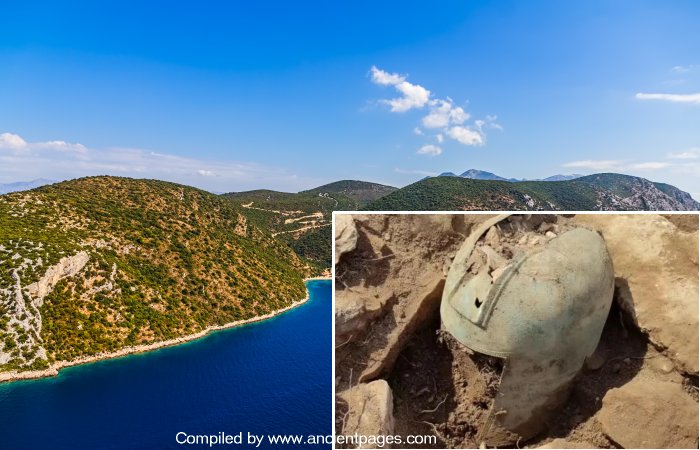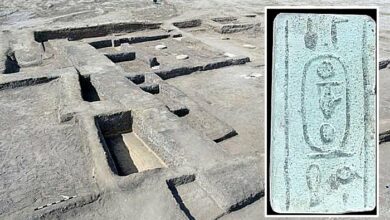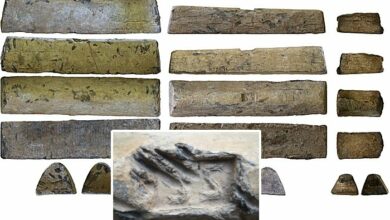2,500-Year-Old Illyrian Helmet Unearthed From Burial Mound In Croatia’s Peljesac Peninsula

Jan Bartek – AncientPages.com – Archaeologists have made a significant discovery that sheds new light on the history of the Illyrians, an ancient tribal people from the eastern Adriatic and the Balkans. Near the village of Zakotorac in southern Croatia, a team led by Hrvoje Potrebica from the University of Zagreb unearthed various artifacts from a burial mound, including a remarkable Greco-Illyrian helmet.
Peljesac peninsula in Croatia. Credit: Adobe Stock – Dario Bajurin
This helmet is the second of its kind found in the area, following a similar discovery in 2020. Both helmets date back to the 5th or 6th century B.C. when local Illyrian communities are believed to have thrived. The excavation also yielded lavish jewelry, providing valuable insights into the material culture and craftsmanship of the Illyrians. These findings contribute to understanding this ancient civilization and its interactions with Greek influences in the region.
Image credit: Ivan Pamić
Despite the limited knowledge about their culture and language, the Illyrian civilization is known to have been organized into tribal communities. One notable tribe inhabited the Peljesac region of what is now southern Croatia. This tribe is believed to have prospered due to their control over strategically crucial maritime trade routes around the peninsula. Their strategic location allowed them to regulate and benefit from the flow of goods and resources through these vital maritime channels.
Numerous burial mounds have been discovered in recent years in the area and on nearby islands. While most remain unexamined, the recent findings from sites at Zakotorac and nearby Nakovana suggest these locations may have held special spiritual significance to 5th-century Illyrians from the region.
The Illyrian tribes, who inhabited the eastern Adriatic region since at least the second millennium BC, were eventually conquered by the invading Romans in the latter years of the 1st century BC after a series of brutal conflicts. Their cultural sites and settlements appear to have been abandoned approximately 500 years after the time period associated with the helmets found in these burial mounds.
“They were both found as separate objects, laid in a way which indicates that this was some kind of a cult practice.
Credit: Dolenjski Museum
These were votive gifts left to pay respect to deities or people buried here. We don’t think that they are related to any specific person buried here because the site contains remains of dozens of individuals,” explains archaeologist Hrvoje Potrebica from the University of Zagreb.
“These mounds were likely robbed, probably by the Romans, who arrived here in the last decades of the 1st century BC. At the time Octavian, the future Roman emperor, led military expeditions against Illyrians on the eastern Adriatic,” local historian Ivan Pamic told the Euro News.
“What is very interesting is that two different types appear here in the same place, which speaks of a continuity of power of the respective community. These helmets have always been a symbol of some kind of status and power,” said Professor Hrvoje Potrebica, from the Department of Archeology of the Faculty of Philosophy in Zagreb.
The recent archaeological excavations have unearthed a diverse array of artifacts, including pins, jewelry pieces, buckles, glass beads, and fibulas, which were ancient brooches used for fastening garments. These discoveries shed light on the affluence of local elite classes during that era.
Concurrently, Greek city-states established prosperous colonies throughout the Mediterranean region, with some of the most significant ones located on the present-day Croatian islands of Vis, Hvar, and Korcula, situated just across the narrow Peljesac channel from the mainland inhabited by the Illyrians.
See also: More Archaeology News
“The wealth of this community, which lived here, which can be seen in many artifacts found in burial cairns, most likely came about because of trade and the control of trade routes passing from the southeast towards the northwest and on towards the interior of the Balkans,” says Domagoj Perkic, archeologist and curator at Dubrovnik Archeological Museum.
These findings challenge the conventional narratives about the history of this Mediterranean region, which have traditionally been told through Greek or Roman sources. The discoveries suggest a need to reevaluate the dominant perspectives and incorporate the perspectives of local populations.
Written by Jan Bartek – AncientPages.com Staff Writer







